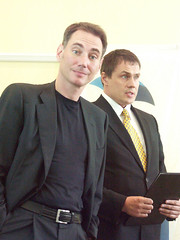The problem is not the paper
 I discussed the San Francisco Chronicle with Thomas Frostberg, at the seminar in Tallin. The Chronicle circulation fell 6.3 percent last year and 16.6 percent the year before.
I discussed the San Francisco Chronicle with Thomas Frostberg, at the seminar in Tallin. The Chronicle circulation fell 6.3 percent last year and 16.6 percent the year before. We’ve both been reporters at the Chronicle. The newspaper is in big economic trouble and have had layoffs right from I worked there in 2004. And the newspaper plans even more layoffs before the year is out.
“The news business is broken, and no one knows how to fix it. … And if any other newspaper says they do, they’re lying”, Editor-in-chief Phil Bronstein told the staff in an “emergency meeting” recently.
Exactly. But there are solutions.
Newspaper circulation is falling in all countries. In the U.S. it has fallen from 80 to 50 percent since the 1960s, but the drop has accelerated the last five years. U.S. daily newspaper circulation slumped 2.8 percent and Sunday circulation fell 3.4 percent during the six months that ended in September.
Los Angeles Times fell 8 percent. The Boston Globe was down 6.7 percent. The Washington Post’s circulation is down 3 percent from 2005. USA Today fell 1.3 percent. Wall Street Journal dropped 1.9 percent. New York Times’ daily circulation was down 3.5 percent.
In the EU newspaper circulation has dropped 5,26 percent on average since 2001. In Japan it fell 3 percent the same period.
The problem is not the paper.
Reading is a habit and preference. If on-line gives you better quality news cheaper, it’s a no-brainer. It’s certainly easier and quicker to find world news online. Things happen around the world all the time and it’s nice to have that information in real time.
If it is easier to read on paper than on-line, the choice is easy. For mobile devices, news headlines are about the only thing that works. To read an entire article requires squishing it to fit and tons of scrolling. I browse the news on my SonyEricsson M600i, get frustrated and pick up Metro or buy a magazine. Screen size does matter. I simply don’t want to bring a big expensive e-news reader like iLiad from iRex, the Sony Reader or Chinese Jinke that run out of batteries, and in addition pay for a subscription.
I don’t believe print is dead – there’s just some natural selection going on. The mainstream media used to live on a distribution chain monopoly; to control the news from the source to the end customer. Now they get competition.
In Sweden, with one of the highest readership numbers in the world, already all Swedish daily newspapers have switched from broadsheet to tabloid.
Free of charge, very successful and profitable, high-quality paper-based newspapers like Metro are getting a foothold. (Metro is a Swedish innovation, btw.)
Swedish evening paper Aftonbladet has heavily invested in their on-line publication and is today the largest news portal in Europe. And very profitable – they bought the largest Swedish site for classified ads Blocket.
What surprises me is that the management at the big daily papers aren’t doing anything. On the contrary all are reacting like Phil Bronstein: downsizing or faking it. At least the Chronicle is honest about their situation. The Chicago-Sun Times, The Dallas Morning News and Newsday was found to have pumped up their circulation with nearly 100,000 non-existing readers. Tut, tut.
It’s about the business model, not rocket science.
PS
I just wrote this and found this:













